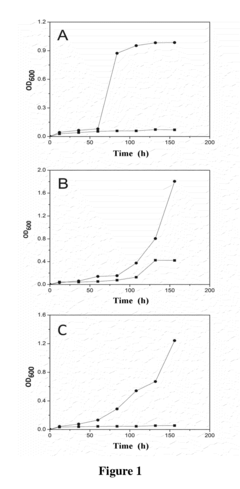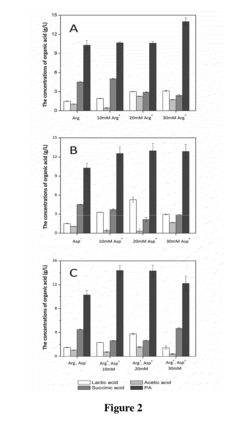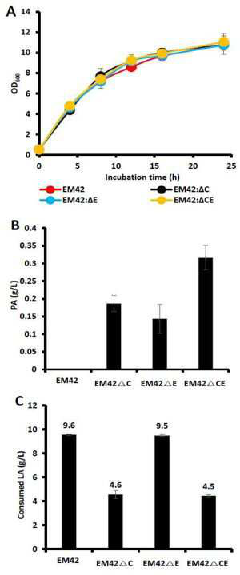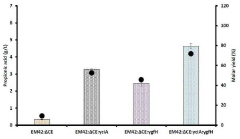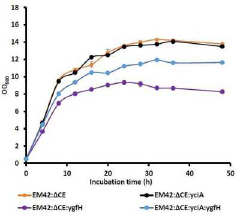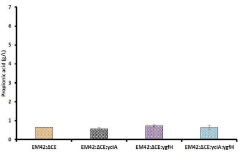Harnessing Propionic Acid for Environmental Sustainability Goals
JUL 3, 20259 MIN READ
Generate Your Research Report Instantly with AI Agent
Patsnap Eureka helps you evaluate technical feasibility & market potential.
Propionic Acid Tech Evolution and Objectives
Propionic acid has emerged as a key player in the pursuit of environmental sustainability goals, with its evolution and applications spanning several decades. The journey of harnessing propionic acid for eco-friendly purposes began in the mid-20th century when researchers first recognized its potential as a natural preservative. This initial discovery laid the foundation for further exploration into its diverse applications and environmental benefits.
As environmental concerns gained prominence in the late 20th and early 21st centuries, the focus on propionic acid shifted towards its role in reducing greenhouse gas emissions and promoting sustainable agriculture. Scientists and industry experts began investigating its use as a feed additive to improve livestock efficiency and reduce methane production in ruminants. This application not only addressed environmental issues but also aligned with the growing demand for sustainable food production methods.
The technological evolution of propionic acid production has been marked by significant milestones. Traditional petrochemical-based production methods have gradually given way to more sustainable bio-based processes. Fermentation technologies using renewable resources such as glucose or glycerol have been developed, offering a greener alternative to conventional synthesis routes. These advancements have not only reduced the carbon footprint of propionic acid production but also opened up new possibilities for its integration into circular economy models.
In recent years, the objectives for harnessing propionic acid have expanded beyond its initial applications. Researchers are now exploring its potential in biodegradable plastics, as a platform chemical for various green products, and even in energy storage systems. The versatility of propionic acid has positioned it as a valuable asset in the transition towards a more sustainable chemical industry.
The current technological landscape surrounding propionic acid is characterized by a focus on process optimization, yield improvement, and the development of novel applications. Biotechnology and genetic engineering are playing crucial roles in enhancing microbial strains for more efficient propionic acid production. Simultaneously, efforts are being made to integrate propionic acid production with other industrial processes, creating synergies that maximize resource utilization and minimize waste.
Looking ahead, the objectives for propionic acid in environmental sustainability are ambitious and multifaceted. There is a growing emphasis on developing closed-loop systems where propionic acid serves as both a product and a feedstock for other sustainable processes. Additionally, researchers are exploring its potential in carbon capture and utilization technologies, aiming to transform this organic acid into a tool for actively combating climate change.
As environmental concerns gained prominence in the late 20th and early 21st centuries, the focus on propionic acid shifted towards its role in reducing greenhouse gas emissions and promoting sustainable agriculture. Scientists and industry experts began investigating its use as a feed additive to improve livestock efficiency and reduce methane production in ruminants. This application not only addressed environmental issues but also aligned with the growing demand for sustainable food production methods.
The technological evolution of propionic acid production has been marked by significant milestones. Traditional petrochemical-based production methods have gradually given way to more sustainable bio-based processes. Fermentation technologies using renewable resources such as glucose or glycerol have been developed, offering a greener alternative to conventional synthesis routes. These advancements have not only reduced the carbon footprint of propionic acid production but also opened up new possibilities for its integration into circular economy models.
In recent years, the objectives for harnessing propionic acid have expanded beyond its initial applications. Researchers are now exploring its potential in biodegradable plastics, as a platform chemical for various green products, and even in energy storage systems. The versatility of propionic acid has positioned it as a valuable asset in the transition towards a more sustainable chemical industry.
The current technological landscape surrounding propionic acid is characterized by a focus on process optimization, yield improvement, and the development of novel applications. Biotechnology and genetic engineering are playing crucial roles in enhancing microbial strains for more efficient propionic acid production. Simultaneously, efforts are being made to integrate propionic acid production with other industrial processes, creating synergies that maximize resource utilization and minimize waste.
Looking ahead, the objectives for propionic acid in environmental sustainability are ambitious and multifaceted. There is a growing emphasis on developing closed-loop systems where propionic acid serves as both a product and a feedstock for other sustainable processes. Additionally, researchers are exploring its potential in carbon capture and utilization technologies, aiming to transform this organic acid into a tool for actively combating climate change.
Market Analysis for Sustainable Propionic Acid
The market for sustainable propionic acid is experiencing significant growth driven by increasing environmental concerns and the shift towards eco-friendly production methods. Propionic acid, traditionally derived from petrochemical sources, is now being produced through more sustainable processes, aligning with global sustainability goals.
The demand for sustainable propionic acid is primarily fueled by its diverse applications across various industries. In the food and beverage sector, it serves as a natural preservative, extending the shelf life of products while meeting consumer preferences for clean label ingredients. The animal feed industry utilizes propionic acid as an effective mold inhibitor, contributing to improved feed quality and animal health.
The personal care and cosmetics industry is another key market for sustainable propionic acid, where it is used in formulations as a pH adjuster and antimicrobial agent. As consumers become more conscious of the environmental impact of their personal care products, the demand for sustainably sourced ingredients continues to rise.
In the pharmaceutical sector, propionic acid finds applications in drug formulations and as a precursor for various active pharmaceutical ingredients. The industry's focus on reducing its carbon footprint has led to increased interest in sustainably produced propionic acid.
The agricultural sector presents a growing market for sustainable propionic acid, particularly in crop protection and soil treatment applications. As farmers seek environmentally friendly alternatives to conventional agrochemicals, bio-based propionic acid offers a promising solution.
Market analysis indicates that the Asia-Pacific region is expected to witness the highest growth rate in the sustainable propionic acid market. This is attributed to rapid industrialization, increasing awareness of environmental issues, and stringent regulations promoting the use of eco-friendly chemicals.
North America and Europe remain significant markets, driven by established regulations supporting sustainable practices and a strong presence of end-use industries. The European Union's commitment to reducing greenhouse gas emissions and promoting a circular economy further bolsters the market for sustainable propionic acid in the region.
The market is characterized by ongoing research and development efforts to improve production efficiency and reduce costs associated with sustainable propionic acid. Innovations in fermentation technologies and the use of renewable feedstocks are expected to drive market growth and enhance the competitiveness of sustainable propionic acid against its petrochemical counterparts.
As industries continue to prioritize sustainability in their operations and product offerings, the market for sustainable propionic acid is projected to expand further. This growth is supported by increasing consumer awareness, regulatory pressures, and corporate sustainability commitments across various sectors.
The demand for sustainable propionic acid is primarily fueled by its diverse applications across various industries. In the food and beverage sector, it serves as a natural preservative, extending the shelf life of products while meeting consumer preferences for clean label ingredients. The animal feed industry utilizes propionic acid as an effective mold inhibitor, contributing to improved feed quality and animal health.
The personal care and cosmetics industry is another key market for sustainable propionic acid, where it is used in formulations as a pH adjuster and antimicrobial agent. As consumers become more conscious of the environmental impact of their personal care products, the demand for sustainably sourced ingredients continues to rise.
In the pharmaceutical sector, propionic acid finds applications in drug formulations and as a precursor for various active pharmaceutical ingredients. The industry's focus on reducing its carbon footprint has led to increased interest in sustainably produced propionic acid.
The agricultural sector presents a growing market for sustainable propionic acid, particularly in crop protection and soil treatment applications. As farmers seek environmentally friendly alternatives to conventional agrochemicals, bio-based propionic acid offers a promising solution.
Market analysis indicates that the Asia-Pacific region is expected to witness the highest growth rate in the sustainable propionic acid market. This is attributed to rapid industrialization, increasing awareness of environmental issues, and stringent regulations promoting the use of eco-friendly chemicals.
North America and Europe remain significant markets, driven by established regulations supporting sustainable practices and a strong presence of end-use industries. The European Union's commitment to reducing greenhouse gas emissions and promoting a circular economy further bolsters the market for sustainable propionic acid in the region.
The market is characterized by ongoing research and development efforts to improve production efficiency and reduce costs associated with sustainable propionic acid. Innovations in fermentation technologies and the use of renewable feedstocks are expected to drive market growth and enhance the competitiveness of sustainable propionic acid against its petrochemical counterparts.
As industries continue to prioritize sustainability in their operations and product offerings, the market for sustainable propionic acid is projected to expand further. This growth is supported by increasing consumer awareness, regulatory pressures, and corporate sustainability commitments across various sectors.
Current Challenges in Propionic Acid Production
The production of propionic acid faces several significant challenges that hinder its widespread adoption for environmental sustainability goals. One of the primary issues is the high production cost associated with traditional petrochemical-based methods. These processes rely heavily on fossil fuel feedstocks, which are not only environmentally unsustainable but also subject to price volatility and supply chain disruptions.
Another major challenge is the low yield and productivity of current production methods. Conventional fermentation processes, while more environmentally friendly, often result in low concentrations of propionic acid, necessitating energy-intensive downstream processing for purification. This inefficiency not only increases production costs but also limits the scalability of bio-based production methods.
The environmental impact of propionic acid production remains a significant concern. Petrochemical routes generate substantial greenhouse gas emissions and produce toxic by-products, contributing to air and water pollution. While bio-based production methods offer a more sustainable alternative, they still face challenges in terms of resource consumption, particularly water usage and the potential competition with food crops for agricultural land.
Process optimization and control present ongoing difficulties in propionic acid production. Maintaining optimal conditions for microbial fermentation, such as pH, temperature, and nutrient balance, is crucial for maximizing yield and productivity. However, achieving consistent and stable production at industrial scales remains challenging, often resulting in batch-to-batch variations and reduced overall efficiency.
The limited availability of cost-effective and sustainable raw materials poses another significant hurdle. While renewable feedstocks like glycerol and biomass-derived sugars show promise, their use is often constrained by fluctuating supply and quality inconsistencies. Developing robust processes that can efficiently utilize a diverse range of feedstocks is essential for improving the economic viability and sustainability of propionic acid production.
Lastly, the recovery and purification of propionic acid from fermentation broths present technical challenges. Current separation methods, such as distillation and extraction, are energy-intensive and often require the use of harmful solvents. Developing more efficient and environmentally friendly separation technologies is crucial for reducing the overall environmental footprint of propionic acid production and improving its competitiveness against petrochemical alternatives.
Another major challenge is the low yield and productivity of current production methods. Conventional fermentation processes, while more environmentally friendly, often result in low concentrations of propionic acid, necessitating energy-intensive downstream processing for purification. This inefficiency not only increases production costs but also limits the scalability of bio-based production methods.
The environmental impact of propionic acid production remains a significant concern. Petrochemical routes generate substantial greenhouse gas emissions and produce toxic by-products, contributing to air and water pollution. While bio-based production methods offer a more sustainable alternative, they still face challenges in terms of resource consumption, particularly water usage and the potential competition with food crops for agricultural land.
Process optimization and control present ongoing difficulties in propionic acid production. Maintaining optimal conditions for microbial fermentation, such as pH, temperature, and nutrient balance, is crucial for maximizing yield and productivity. However, achieving consistent and stable production at industrial scales remains challenging, often resulting in batch-to-batch variations and reduced overall efficiency.
The limited availability of cost-effective and sustainable raw materials poses another significant hurdle. While renewable feedstocks like glycerol and biomass-derived sugars show promise, their use is often constrained by fluctuating supply and quality inconsistencies. Developing robust processes that can efficiently utilize a diverse range of feedstocks is essential for improving the economic viability and sustainability of propionic acid production.
Lastly, the recovery and purification of propionic acid from fermentation broths present technical challenges. Current separation methods, such as distillation and extraction, are energy-intensive and often require the use of harmful solvents. Developing more efficient and environmentally friendly separation technologies is crucial for reducing the overall environmental footprint of propionic acid production and improving its competitiveness against petrochemical alternatives.
Existing Sustainable Production Methods
01 Production methods of propionic acid
Various methods are employed for the production of propionic acid, including fermentation processes, chemical synthesis, and catalytic reactions. These methods often involve the use of specific microorganisms, catalysts, or chemical precursors to efficiently produce propionic acid on an industrial scale.- Production methods of propionic acid: Various methods are employed for the production of propionic acid, including fermentation processes, chemical synthesis, and catalytic reactions. These methods often involve the use of specific microorganisms, catalysts, or chemical precursors to efficiently produce propionic acid on an industrial scale.
- Applications of propionic acid in food preservation: Propionic acid and its salts are widely used as food preservatives due to their antimicrobial properties. They are effective in preventing mold growth and extending the shelf life of various food products, particularly in baked goods, dairy products, and animal feed.
- Use of propionic acid in pharmaceutical formulations: Propionic acid and its derivatives find applications in the pharmaceutical industry. They are used in the formulation of various medications, including topical treatments and oral drugs, due to their antimicrobial properties and ability to enhance drug absorption.
- Industrial applications of propionic acid: Propionic acid has diverse industrial applications beyond food and pharmaceuticals. It is used in the production of plastics, herbicides, and as a chemical intermediate in the synthesis of various compounds. Its versatility makes it valuable in multiple manufacturing processes.
- Environmental and safety considerations in propionic acid handling: The handling and storage of propionic acid require specific safety measures due to its corrosive nature and potential environmental impact. Proper containment, neutralization techniques, and waste management practices are essential to ensure safe use and minimize environmental risks associated with propionic acid.
02 Applications of propionic acid in food preservation
Propionic acid and its salts are widely used as food preservatives due to their antimicrobial properties. They are effective in inhibiting the growth of mold and certain bacteria, thereby extending the shelf life of various food products, particularly baked goods and dairy products.Expand Specific Solutions03 Use of propionic acid in pharmaceutical formulations
Propionic acid and its derivatives find applications in the pharmaceutical industry. They are used in the formulation of various medications, including topical treatments for skin conditions and as intermediates in the synthesis of certain drugs.Expand Specific Solutions04 Environmental and agricultural applications of propionic acid
Propionic acid has applications in environmental and agricultural sectors. It is used in the treatment of wastewater, as a herbicide, and in the production of biodegradable plastics. In agriculture, it serves as a feed preservative and can improve animal nutrition.Expand Specific Solutions05 Industrial uses and derivatives of propionic acid
Propionic acid is utilized in various industrial processes and serves as a precursor for the production of other chemicals. It is used in the manufacture of plastics, perfumes, and solvents. Additionally, propionic acid derivatives have applications in the production of pharmaceuticals, pesticides, and other specialty chemicals.Expand Specific Solutions
Key Players in Propionic Acid Industry
The propionic acid market for environmental sustainability is in a growth phase, driven by increasing demand for eco-friendly solutions. The market size is expanding as industries seek sustainable alternatives, with a projected CAGR of 3-5% over the next five years. Technologically, the field is advancing rapidly, with companies like Dow Global Technologies, Evonik Operations, and Arkema France leading innovation. These firms are developing novel production methods and applications, focusing on bio-based propionic acid and its derivatives. Universities such as The Ohio State University and Tongji University are contributing to research, particularly in areas of green chemistry and sustainable processes, indicating a collaborative ecosystem between industry and academia.
China Petroleum & Chemical Corp.
Technical Solution: China Petroleum & Chemical Corp. (Sinopec) has developed an innovative approach to harness propionic acid for environmental sustainability. Their process involves the catalytic oxidation of propane to propionic acid using a novel heterogeneous catalyst system[1]. This method significantly reduces carbon emissions compared to traditional petrochemical routes. The company has also implemented a closed-loop recycling system for propionic acid production, minimizing waste and improving resource efficiency[2]. Additionally, Sinopec has integrated propionic acid production with their existing refinery operations, utilizing waste streams as feedstock, thus further enhancing sustainability[3].
Strengths: Integrated production system, reduced carbon footprint, efficient resource utilization. Weaknesses: High initial investment costs, potential catalyst deactivation issues.
Novozymes, Inc.
Technical Solution: Novozymes has pioneered an enzymatic approach to propionic acid production, leveraging their expertise in industrial biotechnology. Their process uses specialized enzymes to convert renewable substrates into propionic acid under mild conditions, significantly reducing energy requirements[7]. The company has developed a continuous production system that allows for high productivity and efficient use of resources[8]. Novozymes has also focused on optimizing downstream processing, implementing advanced separation techniques to ensure high product purity while minimizing waste[9]. Additionally, they have explored the use of propionic acid in sustainable animal feed additives, contributing to reduced methane emissions in livestock farming.
Strengths: Low energy consumption, continuous production capability, applications in sustainable agriculture. Weaknesses: Enzyme stability and cost considerations, potential substrate limitations.
Innovative Propionic Acid Synthesis Approaches
Method for Improving Acid tolerance of Propionibacterium acdipropionici
PatentInactiveUS20140178952A1
Innovation
- Adding arginine and/or aspartic acid to the culture medium during the cultivation of Propionibacterium acdipropionici to enhance acid tolerance and propionic acid productivity.
Bioproduction of Propionic Acid from Levulinic Acid by Utilizing Recombinant Pseudomonas putida
PatentInactiveKR1020240029628A
Innovation
- A transgenic Pseudomonas putida strain is developed by deleting prpC and prpE genes and expressing yciA and ygfH genes, utilizing levulinic acid as a substrate to enhance propionic acid production through a levulinic acid-inducible expression system, optimizing the metabolic pathway to improve titer and yield.
Environmental Impact Assessment
The environmental impact assessment of harnessing propionic acid for sustainability goals reveals both positive and negative effects. On the positive side, propionic acid production from renewable resources can significantly reduce greenhouse gas emissions compared to petrochemical-based production methods. Studies have shown that bio-based propionic acid can achieve up to 50% reduction in carbon footprint, contributing to climate change mitigation efforts.
Furthermore, propionic acid's applications in food preservation and animal feed additives can indirectly benefit the environment by reducing food waste and improving livestock feed efficiency. This leads to decreased pressure on land use for agriculture and reduced methane emissions from livestock. The antimicrobial properties of propionic acid also contribute to reduced use of synthetic preservatives and antibiotics, potentially lowering the risk of environmental contamination.
However, the environmental impact of propionic acid production is not without challenges. Large-scale fermentation processes for bio-based production can consume significant amounts of water and energy. Proper waste management is crucial to prevent the release of organic pollutants into water bodies. Additionally, the use of agricultural feedstocks for propionic acid production may compete with food crops for land and resources, potentially leading to indirect land-use changes and associated environmental impacts.
The life cycle assessment of propionic acid production and use must consider the entire value chain, from raw material sourcing to end-of-life disposal. Sustainable sourcing of feedstocks, optimization of production processes, and responsible waste management are key factors in minimizing negative environmental impacts. Innovations in green chemistry and bioengineering offer promising avenues for improving the environmental profile of propionic acid production.
When used in industrial applications, propionic acid can contribute to the development of more environmentally friendly products. For instance, its role in biodegradable plastics and eco-friendly coatings supports the transition towards a circular economy. However, proper disposal and recycling infrastructure must be in place to fully realize these benefits and prevent potential environmental contamination.
In conclusion, while harnessing propionic acid for sustainability goals offers significant environmental benefits, careful management and continuous improvement of production processes are essential to mitigate potential negative impacts. A holistic approach considering economic, social, and environmental factors is necessary to ensure the sustainable development and application of propionic acid technologies.
Furthermore, propionic acid's applications in food preservation and animal feed additives can indirectly benefit the environment by reducing food waste and improving livestock feed efficiency. This leads to decreased pressure on land use for agriculture and reduced methane emissions from livestock. The antimicrobial properties of propionic acid also contribute to reduced use of synthetic preservatives and antibiotics, potentially lowering the risk of environmental contamination.
However, the environmental impact of propionic acid production is not without challenges. Large-scale fermentation processes for bio-based production can consume significant amounts of water and energy. Proper waste management is crucial to prevent the release of organic pollutants into water bodies. Additionally, the use of agricultural feedstocks for propionic acid production may compete with food crops for land and resources, potentially leading to indirect land-use changes and associated environmental impacts.
The life cycle assessment of propionic acid production and use must consider the entire value chain, from raw material sourcing to end-of-life disposal. Sustainable sourcing of feedstocks, optimization of production processes, and responsible waste management are key factors in minimizing negative environmental impacts. Innovations in green chemistry and bioengineering offer promising avenues for improving the environmental profile of propionic acid production.
When used in industrial applications, propionic acid can contribute to the development of more environmentally friendly products. For instance, its role in biodegradable plastics and eco-friendly coatings supports the transition towards a circular economy. However, proper disposal and recycling infrastructure must be in place to fully realize these benefits and prevent potential environmental contamination.
In conclusion, while harnessing propionic acid for sustainability goals offers significant environmental benefits, careful management and continuous improvement of production processes are essential to mitigate potential negative impacts. A holistic approach considering economic, social, and environmental factors is necessary to ensure the sustainable development and application of propionic acid technologies.
Regulatory Framework for Sustainable Chemicals
The regulatory framework for sustainable chemicals plays a crucial role in promoting the use of propionic acid for environmental sustainability goals. As governments and international organizations increasingly prioritize environmental protection and sustainable development, they have implemented various regulations and policies to encourage the adoption of eco-friendly chemicals and processes.
In the European Union, the REACH (Registration, Evaluation, Authorization, and Restriction of Chemicals) regulation serves as a cornerstone for chemical management. Under REACH, propionic acid manufacturers and importers must register their substances and provide detailed information on their properties, hazards, and safe use. This regulation ensures that the environmental and health impacts of propionic acid are thoroughly assessed and mitigated.
The United States Environmental Protection Agency (EPA) has established the Safer Choice program, which recognizes products that contain ingredients that are safer for human health and the environment. Propionic acid, when used in environmentally sustainable applications, may qualify for this program, providing manufacturers with a competitive advantage in the market.
Many countries have implemented green chemistry initiatives to promote the development and use of sustainable chemicals. These initiatives often include tax incentives, research grants, and preferential procurement policies for products that incorporate environmentally friendly substances like propionic acid.
The United Nations Sustainable Development Goals (SDGs) have also influenced regulatory frameworks worldwide. Goal 12, "Responsible Consumption and Production," has led to the creation of policies that encourage the use of sustainable chemicals in various industries. This has indirectly boosted the adoption of propionic acid in environmentally friendly applications.
International standards, such as ISO 14001 for environmental management systems, provide a framework for organizations to improve their environmental performance. Companies utilizing propionic acid in sustainable ways can leverage these standards to demonstrate their commitment to environmental stewardship and comply with regulatory requirements.
The circular economy concept has gained traction in recent years, leading to regulations that promote the reuse and recycling of chemicals. Propionic acid, being biodegradable and derived from renewable resources in some production methods, aligns well with these circular economy principles and related regulations.
As climate change concerns intensify, many jurisdictions have implemented carbon pricing mechanisms and emissions trading schemes. These regulatory tools indirectly support the use of propionic acid in sustainable applications by making carbon-intensive alternatives less economically viable.
Overall, the regulatory framework for sustainable chemicals is evolving to create a more favorable environment for the adoption of environmentally friendly substances like propionic acid. This shift in regulations is driving innovation, research, and investment in sustainable chemical solutions, positioning propionic acid as a key player in achieving environmental sustainability goals across various industries.
In the European Union, the REACH (Registration, Evaluation, Authorization, and Restriction of Chemicals) regulation serves as a cornerstone for chemical management. Under REACH, propionic acid manufacturers and importers must register their substances and provide detailed information on their properties, hazards, and safe use. This regulation ensures that the environmental and health impacts of propionic acid are thoroughly assessed and mitigated.
The United States Environmental Protection Agency (EPA) has established the Safer Choice program, which recognizes products that contain ingredients that are safer for human health and the environment. Propionic acid, when used in environmentally sustainable applications, may qualify for this program, providing manufacturers with a competitive advantage in the market.
Many countries have implemented green chemistry initiatives to promote the development and use of sustainable chemicals. These initiatives often include tax incentives, research grants, and preferential procurement policies for products that incorporate environmentally friendly substances like propionic acid.
The United Nations Sustainable Development Goals (SDGs) have also influenced regulatory frameworks worldwide. Goal 12, "Responsible Consumption and Production," has led to the creation of policies that encourage the use of sustainable chemicals in various industries. This has indirectly boosted the adoption of propionic acid in environmentally friendly applications.
International standards, such as ISO 14001 for environmental management systems, provide a framework for organizations to improve their environmental performance. Companies utilizing propionic acid in sustainable ways can leverage these standards to demonstrate their commitment to environmental stewardship and comply with regulatory requirements.
The circular economy concept has gained traction in recent years, leading to regulations that promote the reuse and recycling of chemicals. Propionic acid, being biodegradable and derived from renewable resources in some production methods, aligns well with these circular economy principles and related regulations.
As climate change concerns intensify, many jurisdictions have implemented carbon pricing mechanisms and emissions trading schemes. These regulatory tools indirectly support the use of propionic acid in sustainable applications by making carbon-intensive alternatives less economically viable.
Overall, the regulatory framework for sustainable chemicals is evolving to create a more favorable environment for the adoption of environmentally friendly substances like propionic acid. This shift in regulations is driving innovation, research, and investment in sustainable chemical solutions, positioning propionic acid as a key player in achieving environmental sustainability goals across various industries.
Unlock deeper insights with Patsnap Eureka Quick Research — get a full tech report to explore trends and direct your research. Try now!
Generate Your Research Report Instantly with AI Agent
Supercharge your innovation with Patsnap Eureka AI Agent Platform!
